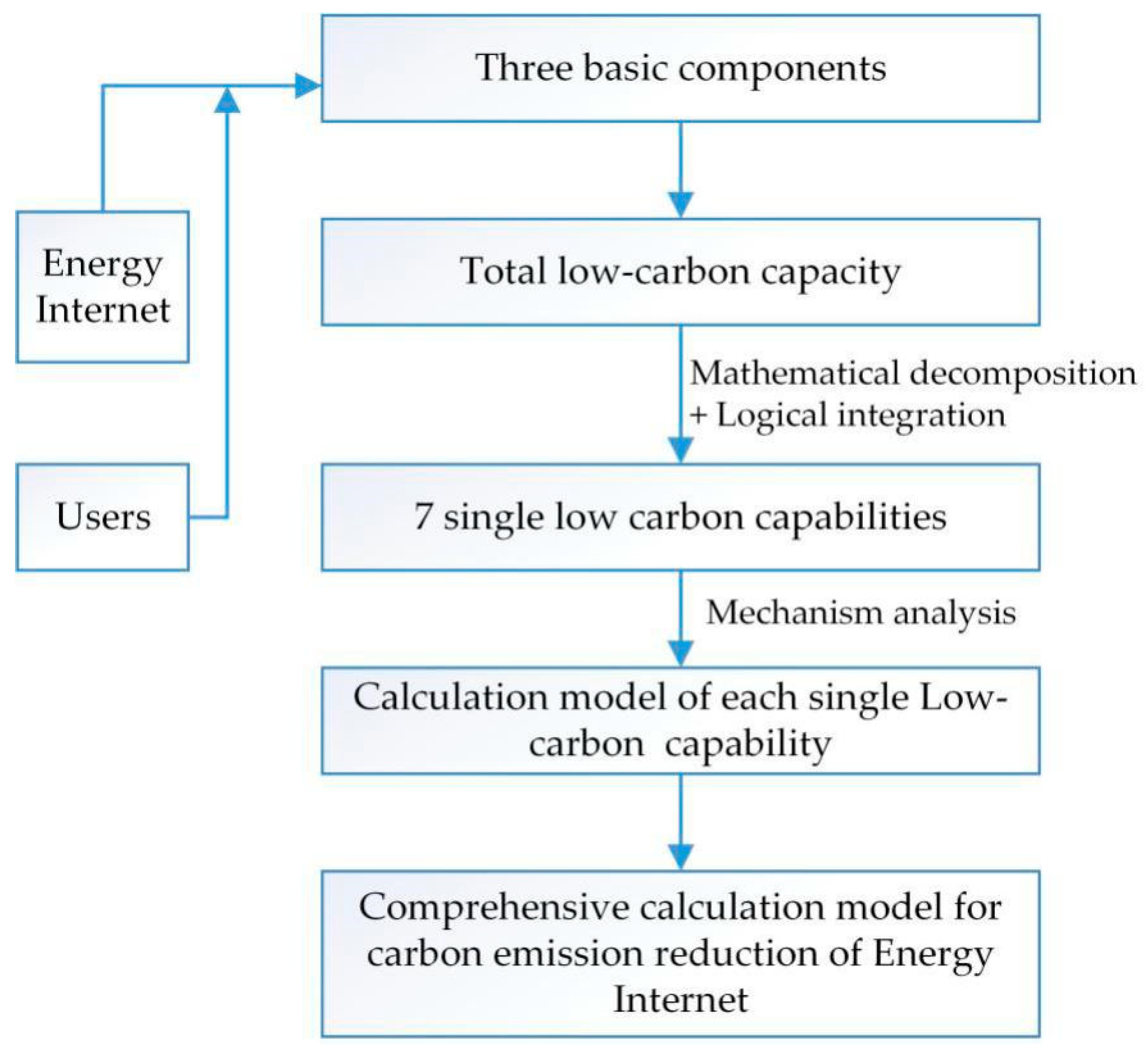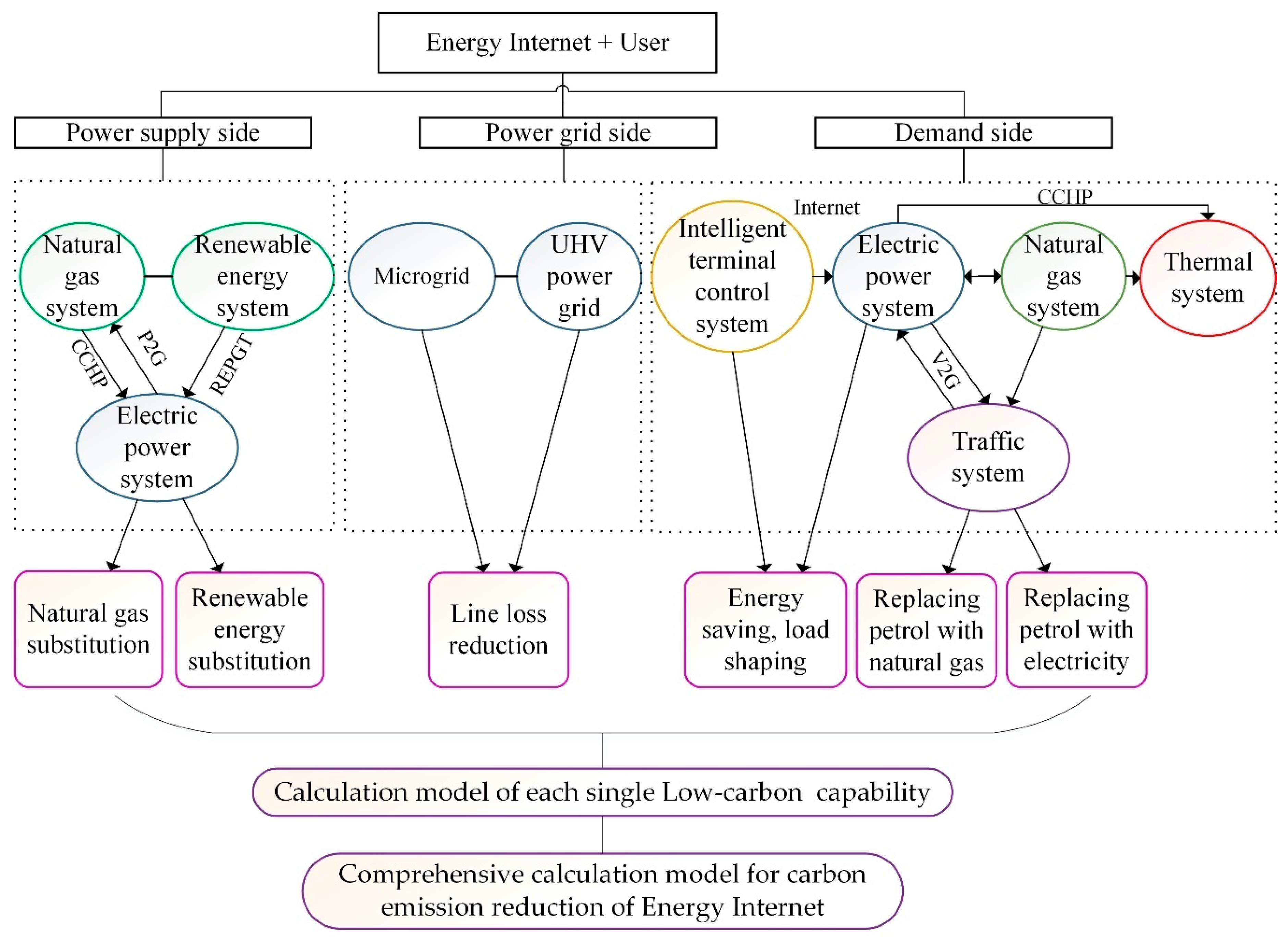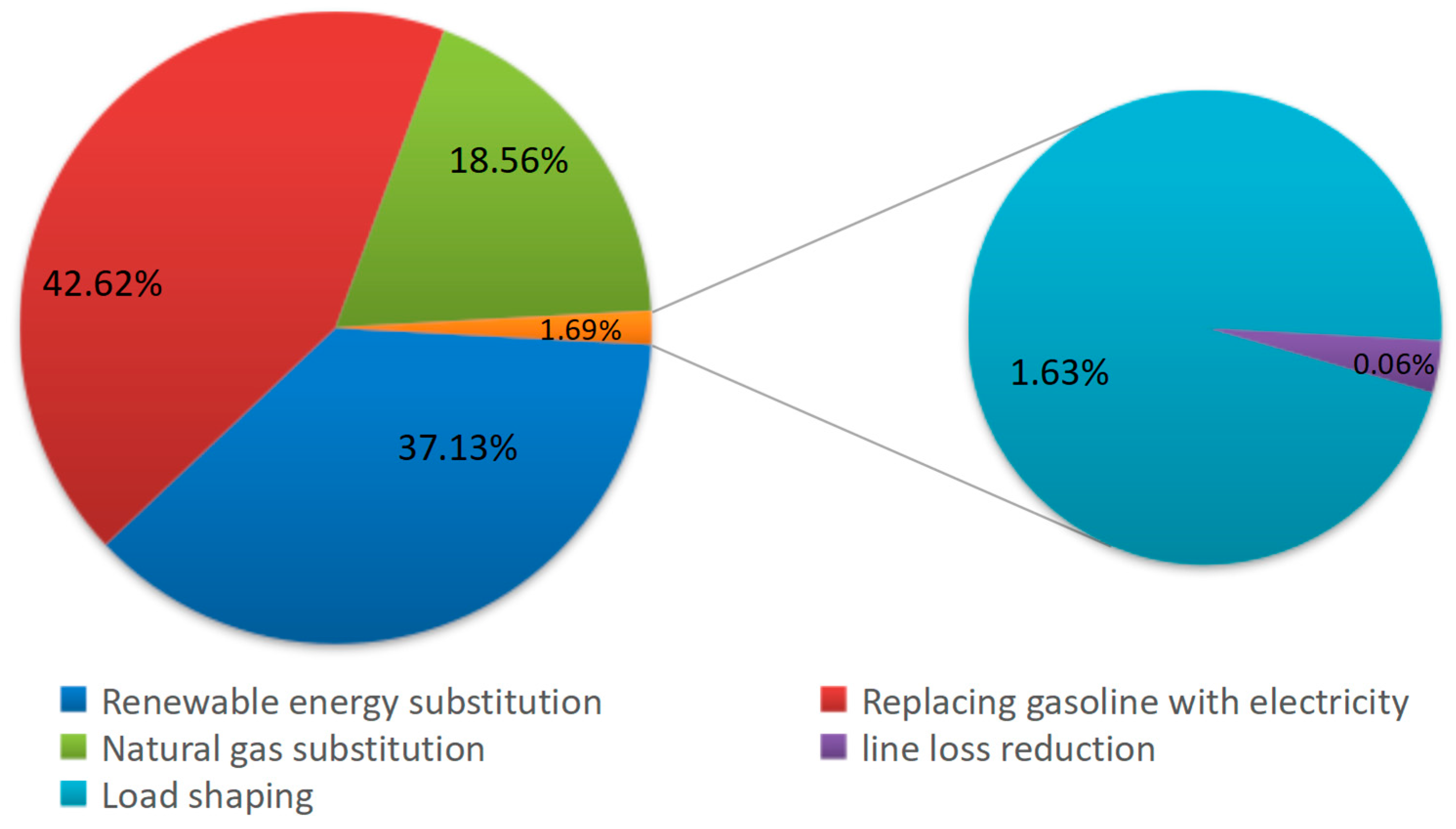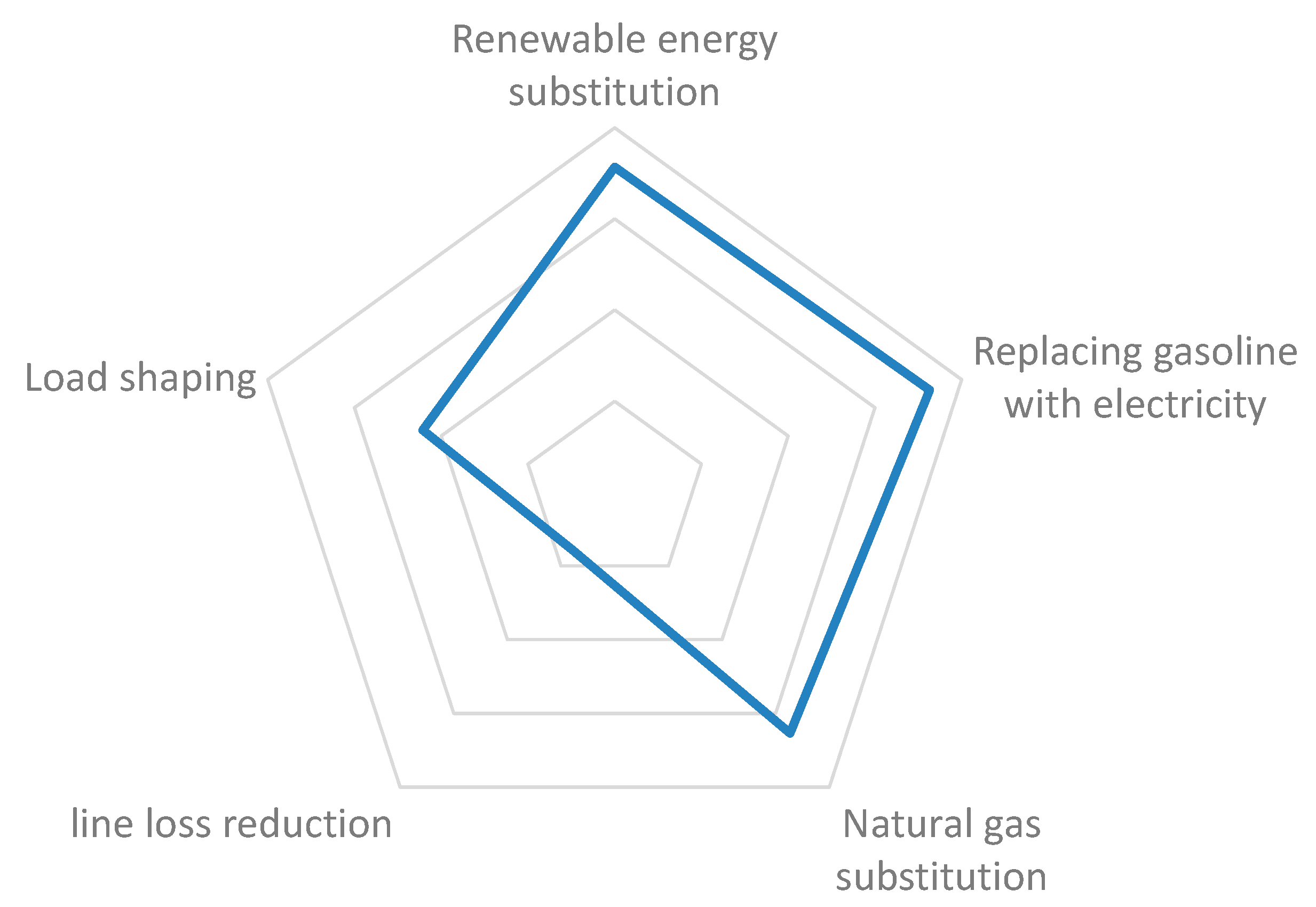A Calculation Model for CO2 Emission Reduction of Energy Internet: A Case Study of Yanqing
Abstract
1. Introduction
2. Methods
2.1. Technical Route
2.1.1. Mathematical Decomposition Method
- (yj − y0)α0 indicates the CO2 emissions reduction generated by the increased amount of clean energy generation.
- [(p0 − q0) − (pj − qj)]α0 represents the CO2 emissions reduction caused by the reduction in the loss of the transmission line.
- (q0 − qj)α0 indicates the CO2 emissions reduction (positive or negative) due to the amount of power saving (negative power saving).
- α0xj − αjxj indicates the CO2 emissions reduction due to the decrease in the emission coefficient of the thermal power unit.
2.1.2. Logical Integration Method
2.2. Calculation Model of CO2 Emission Reduction on Power Supply Side
2.2.1. Mechanism Analysis of Energy Saving and Emission Reduction on Power Supply Side
2.2.2. Renewable Energy Substitution
2.2.3. Natural Gas Substitution
2.3. Calculation Model of CO2 Emission Reduction on the Power Grid Side
2.3.1. Mechanism Analysis of Energy Saving and Emission Reduction on Power Grid Side
2.3.2. Line Loss Reduction
2.4. Calculation Model of CO2 Emission Reduction on the Demand Side
2.4.1. Mechanism Analysis of Energy Saving and Emission Reduction on Demand Side
2.4.2. Energy Saving
2.4.3. Load Shaping
2.4.4. Electrification of Energy-Using Terminal
2.5. Comprehensive Calculation Model of CO2 Emission Reduction for Energy Internet
3. Results
3.1. Yanqing Energy Internet Demonstration Zone
3.2. Data
3.2.1. Power Supply Side
3.2.2. Power Grid Side
3.2.3. Demand Side
3.3. Total Carbon Emission Reduction and Contribution Rate of Each Ability
4. Discussion
4.1. CO2 Emissions Reduction of Energy Internet
4.2. Contribution of Each Capability to Carbon Emission Reduction
4.3. Model Rationality
4.4. Dimension of the Calculation Model
4.5. Model Suitability
5. Conclusions
- (1)
- The model given in this paper was the calculation model for CO2 emissions reduction under the regional energy internet. The model has strong versatility and could quantitatively calculate carbon emissions reduction for any built or planned energy internet.
- (2)
- The mathematical decomposition method and logical integration method were combined to study energy saving and emissions reduction of the energy internet. The total low-carbon capability of the energy internet was classified into seven single low-carbon capabilities. This method of processing reasonably avoided any overlap in calculation.
- (3)
- The Yanqing energy internet can reduce CO2 emissions by 14093.19 tons after completion, which shows that the energy internet has a good effect in energy saving and emissions reduction. The national and local governments should introduce relevant policies to speed up the construction of energy internet.
- (4)
- Taking the Yanqing energy internet as an example, it was found that among the seven low-carbon capabilities, “replacing gasoline with electricity” had the highest contribution rate, followed by “renewable energy substitution”. Therefore, in the construction and operation of the energy internet, we should focus on the development and application of power electronics technology related to electric vehicles. At the same time, the government should actively take various measures to promote the sales of electric vehicles on the user side.
- (5)
- Among the seven low-carbon capabilities, the contribution rate of renewable energy substitution ranks second, which indicates that the optimization of the power supply structure is very important in the energy internet. In view of the characteristics of decentralization and randomness of renewable energy, the government should strengthen the construction of the micro-grid for local energy consumption, so that more renewable energy can be connected to the grid.
Author Contributions
Funding
Conflicts of Interest
Abbreviations
| EV | Electric vehicle |
| LAN | Local area network |
| UHV | Ultra-high voltage |
| DC | Direct current |
| ZCE-MEI | Zero-carbon emission micro Energy Internet |
| NSF-CAES | Non-supplementary fired compressed air energy storage |
| SDN | Software defined network |
| FREEDM | Future renewable electric energy delivery and management |
| CCS | Carbon capture and storage |
| REPGT | Renewable energy power generation technology |
| P2G | Power-to-gas |
| V2G | Vehicle-to-grid |
| CCHP | Combined cooling heating and power |
| ICT | Information and communication technologies |
| IoT | Internet of Things |
| DSR | Distribution system reconfiguration |
| ED | Economic dispatch |
| DRED | Distributionally robust optimization (DRO) ED framework |
| Symbols | |
| Power supply side | |
| / | The amount of coal-fired power generation in the base/j-th year (kW∙h) |
| / | The amount of clean energy power generation in the base/j-th year (kW∙h) |
| / | Total amount of power generation in the base/j-th year (kW∙h) |
| / | The amount of total electricity consumption in the base/j-th year (kW∙h) |
| / | The average CO2 emission coefficient of the thermal power unit in the base/j-th year |
| The amount of CO2 emission reduction by renewable energy substitution (ton) | |
| σ | CO2 emission coefficient of coal (tco2/tce) |
| Coal consumption rate of thermal power unit (g/(kW∙h)) | |
| The increase in the amount of electricity generated by the i-th renewable energy (kW∙h) | |
| A ratio that the increased renewable energy power generation can be attributed to the Energy Internet | |
| The increase in natural gas power generation during the calculation period (kW∙h) | |
| A ratio that the increased natural gas power generation can be attributed to the Energy Internet | |
| Power grid side | |
| The line loss rate that can be reduced when the microgrid permeability is 100% | |
| The line loss rate that can be reduced by UHV grids of different voltage levels | |
| The permeability of the UHV grid at different voltage levels in the base year | |
| The predicted amount of power generation in the j-th year (kW∙h) | |
| Demand side | |
| The proportion of the i-th industry in the electricity structure in the j-th year | |
| The interactive energy-saving potential of the i-th industry | |
| The permeability of smart meters in the i-th industry in the j-th year | |
| The average line loss rate under the non Energy Internet | |
| The power consumption of an EV per 100 kilometers (kW∙h/100 km) | |
| The increased number of EVs during the calculation period | |
| The proportion of the i-th industry in the electricity consumption structure in the j-th year | |
| Peak-load shifting potential of the i-th industry based on smart meters | |
| Load scale in the peak period under the non Energy Internet in the j-th year (kW) | |
| Total number of EVs in the j-th year | |
| Proportion of EVs participating in charging in peak period | |
| The average charging power of EVs in peak period (kW) | |
| The proportion of the system load rate being increased in the j-th year | |
| Maximum load in the j-year under the non Energy Internet (kW) | |
| The increased amount of EVs during the calculation period | |
| The average annual mileage of an EV (km) | |
| The amount of fuel consumption of the vehicle ( liters of fuel per 100 kilometers) | |
| CO2 emission coefficient of the fuel | |
| The increased number of gas vehicles during the calculation period | |
| Average annual mileage of a gas vehicle (km) |
References
- Tarroja, B.; Shaffer, B.; Samuelsen, S. The importance of grid integration for achievable greenhouse gas emissions reductions from alternative vehicle technologies. Energy 2015, 87, 504–519. [Google Scholar] [CrossRef]
- Mi, Z.F.; Zhang, Y.K.; Guan, D.B.; Shan, Y.L.; Liu, Z.; Cong, R.G.; Yuan, X.C.; Wei, Y.M. Consumption-based emission accounting for Chinese cities. Appl. Energy 2016, 184, 1073–1081. [Google Scholar] [CrossRef]
- Mi, Z.; Wei, Y.M.; Wang, B.; Meng, J.; Liu, Z.; Shan, Y.L.; Liu, J.R.; Guan, D.B. Socioeconomic impact assessment of China’ s CO2 emissions peak prior to 2030. J. Clean. Prod. 2016, 142, 2227–2236. [Google Scholar] [CrossRef]
- Lehmann, S. Low carbon districts: Mitigating the urban heat island with green roof infrastructure. City Cult. Soc. 2014, 5, 1–8. [Google Scholar] [CrossRef]
- Lasseter, R.H.; Paigi, P. Microgrid: A conceptual solution. In Proceedings of the 2004 IEEE 35th Annual Power Electronics Specialists Conference (IEEE Cat. No.04CH37551), Aachen, Germany, 20–25 June 2004; pp. 4285–4290. [Google Scholar]
- Liu, L.N.; Chen, X.; Lu, Z.M.; Wang, L.H.; Wen, X.M. Mobile-edge computing framework with data compression for wireless network in energy internet. Tsinghua Sci. Technol. 2019, 24, 271–280. [Google Scholar] [CrossRef]
- Ma, T.; Wu, J.; Hao, L. Energy Flow Modeling and Optimal Operation Analysis of Micro Energy Grid Based on Energy Hub. Energy Convers. Manag. 2017, 133, 292–306. [Google Scholar] [CrossRef]
- Yan, Z.; Tao, Z.; Rui, W.; Liu, Y.; Bo, G. A Model Predictive Control Based Distributed Coordination of Multi-microgrids in Energy Interne. Acta Autom. Sin. 2017, 43, 1443–1456. (In Chinese) [Google Scholar]
- Wang, Y.M. The concept and prospects of global energy internet. China Power 2016, 49, 1–5. [Google Scholar]
- Coster, E.J.; Myrzik, J.M.A.; Kruimer, B.; Kling, W.L. Integration Issues of Distributed Generation in Distribution Grids. Proc. IEEE 2011, 99, 28–39. [Google Scholar] [CrossRef]
- Shukla, J.; Das, B.; Pant, V. Stability constrained optimal distribution system reconfiguration considering uncertainties in correlated loads and distributed generations. Int. J. Electr. Power Energy Syst. 2018, 99, 121–133. [Google Scholar] [CrossRef]
- Yao, W.; Zhao, J.; Wen, F.; Xue, Y.; Ledwich, G. A hierarchical decomposition approach for coordinated dispatch of plug-in electric vehicles. IEEE Trans. Power Syst. 2013, 28, 2768–2778. [Google Scholar] [CrossRef]
- Huang, A.Q.; Crow, M.L.; Heydt, G.T.; Zheng, J.P.; Dale, S.J. The Future Renewable Electric Energy Delivery and Management (FREEDM) System: The Energy Internet. Proc. IEEE 2011, 99, 133–148. [Google Scholar] [CrossRef]
- Yang, H.; Yi, D.; Zhao, J.; Dong, Z.Y. Distributed optimal dispatch of virtual power plant via limited communication | NOVA. The University of Newcastle Digital Repository. IEEE Trans. Power Syst. 2013, 28, 3511–3512. [Google Scholar] [CrossRef]
- Deng, X. Study on Insulation Coordination of Converter Stations in UHV DC and Flexible HVDC Transmission Systems. Master’s Thesis, Zhejiang University, Zhejiang, China, 2014. [Google Scholar]
- Li, R.; Chen, L.; Yuan, T.; Li, C. Optimal dispatch of zero-carbon-emission micro Energy Internet integrated with non-supplementary fired compressed air energy storage system. J. Mod. Power Syst. Clean Energy 2016, 4, 566–580. [Google Scholar] [CrossRef]
- Hou, W.; Tian, G.; Guo, L.; Wang, X.; Zhang, X.; Ning, Z. Cooperative Mechanism for Energy Transportation and Storage in Internet of Energy. IEEE Access 2017, 5, 1363–1375. [Google Scholar] [CrossRef]
- Tong, X.; Sun, H.; Luo, X.; Zheng, Q. Distributionally robust chance constrained optimization for economic dispatch in renewable energy integrated systems. J. Glob. Optim. 2018, 70, 131–158. [Google Scholar] [CrossRef]
- Zhou, Z.; Xiong, F.; Xu, C.; Zhou, S.; Gong, J. Energy Management for Energy Internet: A Combination of Game Theory and Big Data-Based Renewable Power Forecasting. In Proceedings of the 2017 IEEE International Conference on Energy Internet (ICEI), Beijing, China, 17–21 April 2017. [Google Scholar]
- Yi, X.; Zhang, J.; Wang, W.; Juneja, A.; Bhattacharya, S. Energy Router: Architectures and Functionalities toward Energy Internet. In Proceedings of the IEEE International Conference on Smart Grid Communications (SmartGridComm), Brussels, Belgium, 17–20 October 2011. [Google Scholar]
- Tapscott, D.; Tapscott, A. How Block Chain Technology can Reinvent the Power Grid. Available online: http://fortune.com/2016/05/15/blockchain-reinvents-power-grid/ (accessed on 15 May 2016).
- Wu, L.; Meng, K.; Xu, S.; Li, S.; Ding, M.; Suo, Y. Democratic Centralism: A Hybrid Blockchain Architecture and Its Applications in Energy Internet. In Proceedings of the IEEE International Conference on Energy Internet (ICEI), Beijing, China, 17–21 April 2017. [Google Scholar] [CrossRef]
- Pan, J.; Jain, R.; Paul, S.; Vu, T.; Saifullah, A.; Sha, M. An Internet of Things Framework for Smart Energy in Buildings: Designs, Prototype, and Experiments. IEEE Internet Things J. 2015, 2, 527–537. [Google Scholar] [CrossRef]
- Huang, A. FREEDM system—A vision for the future grid. In Proceedings of the Power and Energy Society General Meeting, Providence, RI, USA, 25–29 July 2010. [Google Scholar] [CrossRef]
- Zhou, K.; Yang, S.; Shao, Z. Energy Internet: The business perspective. Appl. Energy 2016, 178, 212–222. [Google Scholar] [CrossRef]
- Zhou, Z.; Liu, Y.; Jin, C. Study on construction of low-carbon featured chlor-alkali industry bases energized by non-grid-connected wind power in offshore Jiangsu province. In Proceedings of the World Non-grid-connected Wind Power & Energy Conference, Nanjing, China, 24–26 September 2009. [Google Scholar] [CrossRef]
- Bui, M.; Adjiman, C.S.; Bardow, A.; Anthony, E.J.; Boston, A.; Brown, S.; Fennell, P.S.; Fuss, S.; Galindo, A.; Hackett, L.A.; et al. Carbon capture and storage (CCS): The way forward. Energy Environ. Sci. 2018, 11, 1062–1176. [Google Scholar] [CrossRef]
- Jane, T.H. Biomass power as a strategic business investment. In Proceedings of the 1996 International Joint Power Generation Conference, Houston, TX, USA, 13–17 October 1996; Part 1. pp. 355–364. [Google Scholar]
- Engül, H.; Theis, T.L. An environmental impact assessment of quantum dot photovoltaics (QDPV) from raw material acquisition through use. J. Clean. Prod. 2011, 19, 21–31. [Google Scholar] [CrossRef]
- Zhou, L.S. Research on Key Indicators Selection and Evaluation Model of Smart Grid Low Carbon Benefit; North China Electric Power University: Beijing, China, 2013. [Google Scholar]
- Jia, W.Z.; Kang, C.Q.; Liu, C.L.; Li, M. Capability of smart grid to promote low-carbon development and its benefits evaluation model. Autom. Electr. Power Syst. 2011, 35, 7–12. [Google Scholar]
- Cao, P.; Wang, M.; Guo, C.X.; Bai, Y.H.; Zhou, H.J. Low-carbon comprehensive benefit analysis of intelligent microgrid operation. Power Grid Technol. 2012, 6, 15–20. (In Chinese) [Google Scholar]
- Zhou, T.; Chen, Q.; Zhu, W.; Zhang, L.; Kang, C. A comprehensive low-carbon benefits assessment model for power systems. In Proceedings of the IEEE International Conference on Power System Technology, Auckland, New Zealand, 30 October–2 November 2012. [Google Scholar]
- Li, W.F.; Hui, R.Z.; Sen, G. An Analysis on the Low-carbon Benefits of Smart Grid of China. Phys. Procedia 2012, 24, 328–336. [Google Scholar]
- Sun, S. Research on Energy Saving and Emission Reduction Path of Chinese Power Industry under the Background of Energy Internet. Master’s Thesis, North China Electric Power University, Beijing, China, 2016. [Google Scholar]
- Kang, C.Q.; Zhou, T.R.; Chen, Q.X.; Ge, J. Assessment Model on Low-Carbon Effects of Power Grid and Its Application. Power Syst. Technol. 2009, 33, 1–7. [Google Scholar]
- Cai, T.; Song, B.B.; Wei, Z. Low carbon benefit measurement model based on electric load shaping. China Power 2012, 45, 103–108. [Google Scholar]
- Feng, Q.D. The status quo and development of Energy Internet. Electr. Ind. 2016, 1. (In Chinese) [Google Scholar]
- Li, Z.; Wu, W.; Wang, J.; Zhang, B.; Zheng, T. Transmission-Constrained Unit Commitment Considering Combined Electricity and District Heating Networks. IEEE Trans. Sustain. Energy 2016, 7, 480–492. [Google Scholar] [CrossRef]
- Martin-Martínez, F.; Sánchez-Miralles, A.; Rivier, M. A literature review of Microgrids: A functional layer based classification. Renew. Sustain. Energy Rev. 2016, 62, 1133–1153. [Google Scholar] [CrossRef]
- Qi, Q.R.; Jiang, W.Y.; Liu, J.Q.; Chang, H.; Zhou, Z. Black start method for UH DC-transmitting island system based on flexible direct current transmission technology. Power Constr. 2017, 10. (In Chinese) [Google Scholar]
- Chen, A.W.; Le, Q.M.; Cao, H. Low Carbon Benefit Analysis of Smart Grid in China. Stat. Decis. 2012, 8, 71–74. [Google Scholar]
- Microgrid Permeability. Available online: http://www.docin.com/p-225098761.html (accessed on 18 February 2019).
- Hobbs, B.F.; Oren, S.S. Three Waves of U.S. Reforms: Following the Path of Wholesale Electricity Market Restructuring. IEEE Power Energy Mag. 2019, 17, 73–81. [Google Scholar] [CrossRef]
- Li, Y.; He, L.; Liu, F. Flexible Voltage Control Strategy Considering Distributed Energy Storages for DC Distribution Network. IEEE Trans. Smart Grid 2017, 99, 163–172. [Google Scholar] [CrossRef]
- Fensel, A.; Tomic, D.K.; Koller, A. Contributing to appliances’ energy efficiency with Internet of Things, smart data and user engagement. Future Gener. Comput. Syst. 2016, 76, 329–338. [Google Scholar] [CrossRef]
- Cai, H.; Chen, Q.; Guan, Z. Day-ahead optimal charging/discharging scheduling for electric vehicles in microgrids. Prot. Control. Mod. Power Syst. 2018, 3, 2–69. [Google Scholar] [CrossRef]
- Li, M.; Wu, X.; Zhang, Z.; Yu, G.; Ma, W. A Wireless Charging Facilities Deployment Problem Considering Optimal Traffic Delay and Energy Consumption on Signalized Arterial. IEEE Trans. Intell. Transp. Syst. 2019, 99, 1–12. [Google Scholar] [CrossRef]
- Li, P.; Han, Z.; Jia, X.; Mei, Z.; Han, X.; Wang, Z. Comparative analysis of an organic Rankine cycle with different turbine efficiency models based on multi-objective optimization. Energy Convers. Manag. 2019, 185, 130–142. [Google Scholar] [CrossRef]
- Shi, X.Q.; Li, X.N.; Yang, J.X. Analysis of Carbon Emission Reduction Potential and Its Influencing Factors of Low Carbon Transportation Electric Vehicles. Environ. Sci. 2013, 1, 385–394. [Google Scholar]
- Beijing Municipal Bureau of Statistics Website. Available online: http://www.bjstats.gov.cn/ (accessed on 12 December 2018).
- China Carbon Emissions Trading Network. Available online: http://www.tanpaifang.com/ (accessed on 3 November 2018).
- Polaris Power Network Website. Available online: http://www.bjx.com.cn/ (accessed on 5 February 2019).
- Shi, Y. Analysis of Energy Saving Application under the Background of Energy Internet. J. Harbin Vocat. Tech. Coll. 2017, 5, 92–94. (In Chinese) [Google Scholar]
- Song, J.Z.; Feng, Q.; Wang, X.P.; Fu, H.L.; Jiang, W.; Chen, B.Y. Spatial Association and Effect Evaluation of CO2 Emission in the Chengdu-Chongqing Urban Agglomeration: Quantitative Evidence from Social Network Analysis. Sustainability 2018, 11, 1. [Google Scholar] [CrossRef]
- Liu, R.X. Research and Application of Regional Optimization Energy Saving Model Based on Energy Internet. Master’s Thesis, North China Electric Power University, Beijing, China, 2017. [Google Scholar]
- Luo, Z.W. Development and application of energy storage technology for Energy Internet. Build. Mater. Dev. Orientat. 2017, 15, 117. [Google Scholar]




| Parameter | Value |
|---|---|
| Renewable power generation in 2016 | 82,500 MWh |
| Planned renewable power generation in 2025 | 95,030 MWh |
| CO2 emission coefficient of coal | 2.62 tco2/tce |
| Coal consumption of thermal power unit | 333 g/(kW∙h) |
| Increased natural gas power generation | 12,528 MWh |
| Parameter | Value |
|---|---|
| Increased permeability of microgrids | 0.4% |
| Line loss rate that can be reduced by microgrid | 0.5% |
| Power generation of non-energy internet in 2025 | 925 million kW∙h |
| Industry | Primary Industry | Secondary Industry | Tertiary Industry | Residential Electricity |
|---|---|---|---|---|
| Permeability of smart meter | 70% | 90% | 85% | 90% |
| Electrical consumption structure | 2.48% | 74.92% | 10.55% | 12.05% |
| Energy saving potential | 0.001% | 0.002% | 0.0008% | 0.003% |
| Peak-load shifting capacity | 0.0003% | 0.0005% | 0.0007% | 0.001% |
| Parameter | Value |
|---|---|
| Increased number of EVs | 40,000 |
| Electricity consumed by an EV per 100 kilometers | 18 kW∙h |
| Annual average mileage per EV | 1525 km |
| Average line loss rate under non-energy internet | 6.5% |
| Total number of EVs in 2025 | 100,000 |
| Proportion of EVs participating in charging at peak stage | 0.005 |
| Average charging power of an EV | 10 kW |
| Peak power load scale | 65 MW |
| The sum of the total discharge power of energy storage equipment during peak hours | 0.8 MW |
| The maximum load in Quanyan under the non-energy internet in 2025 | 986,170 MW |
| Reduction of coal consumption caused by increase in load rate | 2.3 g/(kW∙h) |
| Gasoline consumption per 100 kilometers | 8.05 L |
| CO2 emission coefficient of gasoline | 2.3 kg/L |
| Low-Carbon Capacity | The Amount of Total CO2 Emission Reduction |
|---|---|
| Renewable energy substitution | 9838.7 tons |
| Natural gas substitution | 4918.6 tons |
| Line loss reduction | 16.14 tons |
| Energy saving (negative energy saving) | −2566.5 tons |
| Load shaping | 430.8 tons |
| Replacement of gasoline with electricity | 11,294.15 tons |
| Overall carbon emission reduction capacity | 14,093.19 tons |
© 2019 by the authors. Licensee MDPI, Basel, Switzerland. This article is an open access article distributed under the terms and conditions of the Creative Commons Attribution (CC BY) license (http://creativecommons.org/licenses/by/4.0/).
Share and Cite
Yang, S.; Zhang, D.; Li, D. A Calculation Model for CO2 Emission Reduction of Energy Internet: A Case Study of Yanqing. Sustainability 2019, 11, 2502. https://doi.org/10.3390/su11092502
Yang S, Zhang D, Li D. A Calculation Model for CO2 Emission Reduction of Energy Internet: A Case Study of Yanqing. Sustainability. 2019; 11(9):2502. https://doi.org/10.3390/su11092502
Chicago/Turabian StyleYang, Shuxia, Di Zhang, and Dongyan Li. 2019. "A Calculation Model for CO2 Emission Reduction of Energy Internet: A Case Study of Yanqing" Sustainability 11, no. 9: 2502. https://doi.org/10.3390/su11092502
APA StyleYang, S., Zhang, D., & Li, D. (2019). A Calculation Model for CO2 Emission Reduction of Energy Internet: A Case Study of Yanqing. Sustainability, 11(9), 2502. https://doi.org/10.3390/su11092502




